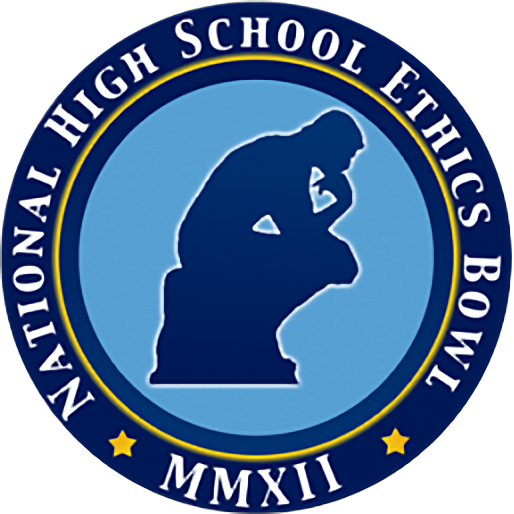
High School Ethics Bowl
by Milan Riley
The National High School Ethics Bowl (NHSEB), first held in 2012, is a competition in which two teams of seven (five participating at a time) discuss real-life ethical dilemmas. Unlike a debate, a team can choose the position they defend and members take turns presenting their opinion. The other team then asks meaningful questions that challenge the morals, values, and efficiency of the opinion. The winner of a match is determined by which side presented their opinions the most thoughtfully and were the most considerate of the moral principles at play.
Structure of the Bowl
At the start of a match, one team is randomly selected to be Team A and the other Team B. Each round consists of five periods:
- Moderator period (~3 min): case introduced
- Presentation period (2 min conferral, 6 min presentation): Team A presents opinion
- Commentary period (2 min conferral, 3 min commentary): Team B asks questions
- Response period (2 min conferral, 3 min commentary): Team A responds
- Judges’ period (10 min Q&A): judges ask questions, Team A responds
During conferral times, teams can discuss and pass notes between themselves to formulate a response. After the round is done, Team A and Team B switch roles and repeat the process with a different case. Finally, judges add up scores for each section and announce the winners.
The Science Academy’s Ethics Club
Co-presidents Elodia Honigstein (9th) and Jordin Lim (9th) created the club that now meets Tuesdays at lunch in Mr. Nuno’s room. There, club members discuss different cases and ethical questions. This year’s Ethics Bowl, held on the 3rd of February, was the club’s first time participating as a team for the Science Academy. The event took place at Chapman University in Orange County. Winning 2 out of our 3 matches, it was a huge success for our school’s first time competing! Hopefully, the Science Academy will perform even better in the future.
The club is open to both middle school and highschool students. If you’re interested in joining, here’s the Schoology group code: N47D-ZK6N-SC3H6. You can also come by to our meetings and check it out!
2024 National High School Ethics Bowl at Chapman University





Read More

Join a Science Academy Club!
By Andi Villamor
Want to make the most of your time at school? Joining a club is the perfect opportunity to explore the world beyond the classroom, meet people who share your interests, develop new skills, and make unforgettable memories. Not to mention, clubs can give you valuable experiences that allow you to develop strong interpersonal and leadership skills, as well as boost your caliber on college applications.
If you went to Club Rush in September but decided that none of the clubs were for you, maybe you just lack the relevant information! This article will detail many of Science Academy’s amazing clubs – and how to join them – through the words of their presidents. Remember, it wouldn’t hurt to simply try out a club by going to a meeting. If you end up changing your mind, then you can always back out, so why not give it a shot? Without further ado, here are some of our most popular clubs and everything you might want to know about them.
Biology Club
Joining this club has major academic benefits, especially for our seventh and ninth graders taking Pre-AP or AP Biology. If you hope to pursue a major or career in biology, being in this club could help you get a great head start and continue to drive your interest in the field.
The club meets during lunch every Monday in Ms. Musial’s room (N313). As the President of Biology Club Ryan Lee says, his club’s goal is to “empower those who wish to pursue biology and to provide a common hub for anything biology-related. If you are having trouble with biology or if you want to pursue a biology-related competition or career, you should join Biology Club in order to enhance your understanding.” During meetings, club officers give biology lectures and extra assistance for students needing help in class.
Interested? Come to the next meeting and join their Schoology Group with this access code: 3WGH-8PX9-XNDND.
Journalism Club
Members of this club write school-appropriate articles of their choice for The Science Academy NewsFlash on the school’s official website. What I personally love about this club is that it is incredibly versatile. Since it only meets from 5:30 – 6:00 PM every other Tuesday on Zoom, members don’t need to worry so much about fitting it into their day and can write at their own pace about nearly anything they want. Additionally, students in this club get the opportunity to express themselves through writing and showcase their articles on the school’s website.
The President of Journalism Club, Milan Riley, encourages you to join: “Members are free to choose any appropriate topics for an article and can write at their own pace. Joining this club will improve writing skills, look good on college applications, and give back to the Science Academy community!”
If you think this club is right for you, join the Journalism Club Schoology Group with this code, FVT4-9PG2-RWPFZ, and stay tuned for the next Zoom meeting!
International Food Club
President of IFC Andi Villamor states, “Our club’s goal is to expose its members to food from all over the world and to give students a safe space where they can share dishes from their own cultures.” Meetings are usually potlucks, during which members bring food to share with one another. Club officers introduce these dishes (ingredients, origins, etc.) before encouraging students to taste the food. However, on some meetings, members – with the officers’ help – may work together to prepare a simple dish, which not only immerses students in foreign cuisines, but also gives them a great time.
International Food Club meets every other Friday at lunch in Ms. Musial’s room (N313). Andi reminds anyone interested in joining that “participation from our members is key. Without sharers or people willing to help out, the club can’t continue. So if you’re thinking about joining, be ready to participate and keep in mind that we’re not just a lunch program. We’re a community dedicated to sharing the world’s food with the students of the Science Academy.”
Want to join the fun? Come to their next meeting and contact them at internationalfoodclub371@gmail.com for information on how to join their Schoology Group.

Martial Arts Club
Esther Chong, President of Martial Arts Club, tells us, “Every meeting follows a flexible schedule. We begin with a respectful bow to one another, followed by 10 minutes of stretching and warm-ups. The next 10-15 minutes are devoted to specific techniques or fundamentals associated with a particular martial art. This can include strikes, blocks, kicks, or other movements, with the goal of improving sparring and form techniques. Of course, students are welcome to eat their lunch before the meeting begins. The main objective of this club is to refine techniques of martial arts, placing emphasis on not only the physical aspects, but also the mental/spiritual qualities of martial arts, promoting values of discipline and perseverance. Through guidance and encouragement in meetings, students are able to improve physical fitness, self-defense skills, and overall well being. In addition, this club is intended to generate interest in martial arts, spreading its values and benefits that may impact one’s life significantly.”
“Overall, joining the Martial Arts club offers a holistic approach to well-being and provides an opportunity for students to engage with other martial artists, or even learn new techniques. Hope to see you at our next meeting!”
Martial Arts Club meets every Wednesday during lunch in the Cardio Room. Join their Schoology group with this code: N7GJ-NWGJ-M65T3.
Ethics Club
This club strives to provide members with impactful insights about themselves and the world around them while allowing students to develop a strong moral compass, a trait that could benefit them for the rest of their lives. During meetings, which occur during lunch every Tuesday in Mr. Nuno’s room N307, members discuss ethical dilemmas and topics.
According to Jordin Lim, Co-President of Ethics Club, “Through this club, we hope to provide students with a place where they can discuss–or do some friendly arguing–with their peers about ethical topics and dilemmas they may find interesting. It really is great fun! You can even come just to listen in on what everyone else has to say; you don’t have to participate in discussion if you don’t want to. Sometimes we even bring little snacks 🙂 We will also be sending out a team to compete in the National Ethics Bowl and although the competition is only open to high schoolers, both middle school and high school students are more than welcome to join our club. If you would like to check out some examples of ethical dilemmas provided by the National Ethics Bowl, look through these https://nhseb.org/case-library. If you’d be excited to approach these cases with your peers or even if you’re curious to find out exactly what ethics is, consider giving the Ethics Club a try!”
Interested? The access code for joining their Schoology Group is N47D-ZK6N-SC3H6 and feel free to drop in to the next meeting.
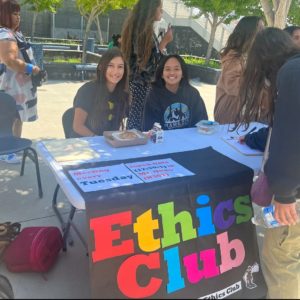
Volleyball Club
Joining this club is a great opportunity to practice volleyball in a more casual and fun setting and meet new people. The club may be of particular interest to players on the varsity or junior varsity volleyball teams that are looking to get some extra practice in as well as to students who want to try out for those teams some day. The club meets every Friday during lunch on the volleyball courts.
Daniel Shin, Co-President of Volleyball Club, says that his club’s goal is to “bring the community together,” and adds, “If you want to get better at volleyball and make some new friends, join us!”
If you’re interested, come to the next meeting and talk to either Dillon Reeves or Daniel Shin to join their Discord server.
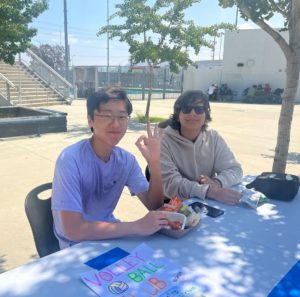
Armenian Club
Milena Karagezyan, President of Armenian Club, tells us, “During meetings, we talk and learn about Armenian history and its future–sharing any new information discovered such as historical events that occurred in Armenia and Greater Armenia. We also watch educational videos and mvoies, listen to and learn authentic Armenian songs, and we may even have a special guest joining us as we did last year. The goal of my club is to teach and inform as many people as possible about Armenia and its history, and hopefully try to help Artsakh and the people from Artsakh through fundraisers and any other ways we can. Members also do fun activities such as playing Kahoot, sharing Armenian food, and so much more. This is a great opportunity for you to learn about a culture that has survived for thousands of years and is one of the oldest surviving countries in the world”
Armenian Club meets every other Thursday during lunch. If you decide to join, you should come to their next meeting in room N313.

Environmental Club
Give back to the environment by joining Environmental Club! This club is great for earning volunteering hours to put on your college application and have a great time earning them. Attend beach and park clean-ups with fellow students as you help care for our planet and maybe even have some lunch with them afterwards. President of Environmental Club Daniel Said says, “The goal of the club is to foster environmental awareness in high schoolers and to make a positive impact in our local environment.”
Interested? Join their Schoology group with this code: 5ZHN-3DS7-B8X3C.

Dungeons & Dragons Club
Among the most popular clubs on campus, Dungeons & Dragons Club is dedicated to bringing our students together through friendly game play. They welcome players of all levels of experience and are open to teach you everything you need to know about this wonderful game. As President of Dungeons & Dragons Club Aidan Khan says, “We are a community of people who do not judge, have fun, and exercise our imaginations.”
The club meets every Wednesday during lunch in room W202 (Mr. Lewis’ room) on the second floor. If you’re interested, come to the next meeting and consult with the club officers.
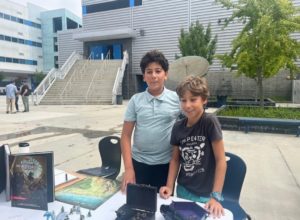

Robotics Champions
By Maleeya Mickelson and Milan Riley
Science Academy is the proud home to a world-renowned Robotics Club! Our teams have received many awards over the years and have brought back multiple wins, not only from local VEX Robotics Competitions (VRC), but from State and even World competitions. This year has continued to showcase the many talents of our students with an especially successful season.
The 2022-2023 Robotics Teams consisted of between two to five members, who worked together on their planning and execution by meeting at least twice a week to get ready for competitions throughout the season. As part of their dedication to the Robotics Program and in preparation for their competitions, teams often met in Science Academy’s on-campus Robotics Lab after school on Tuesdays and Wednesdays. During that same time, advanced robotics mentors provided assistance to students as well.
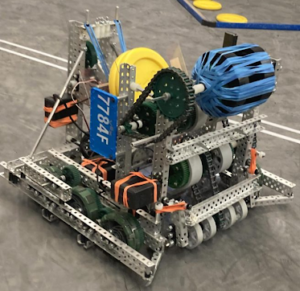 Example of 2023 VEX VRC robot
Example of 2023 VEX VRC robot
Each team strived to build a robot that could compete in all aspects of the game. Every year the game changes, meaning the teams have to create new robots. This year’s game, called “Spin Up”, challenged two alliances, Red and Blue, each made up of two teams. The game started off with a 15-second autonomous period — a period when the two teams used code already pre-made to score as many points as possible. The alliance who scored the most points during this time received a 10-point bonus. The game then moved onto a 1-minute and 45-second long driver control period, where alliances once again had to score as many points as possible. Different ways to score points included shooting discs into the high goal (5 points), getting discs into the low goal (1 point), or spinning the rollers on the field (10 points). During the last 10-seconds of the match, teams could release their robot’s expansions (often made out of string) in order to score even more points by covering the tiles on the field. Every tile the team covered at the end of the game scored them another 3 points.
 The 2023 challenge arena
The 2023 challenge arena
Teams competed in many competitions this season. An overall win at one of the local competitions, as well as winning certain awards that vary from competition to competition could qualify them for the States competitions. At competitions, teams went through multiple rounds with randomly picked alliances in order to determine seeding for the elimination round. After a certain number of rounds, teams then chose their own alliances for playoffs and eliminations. Teams higher on the seeding chart received the chance to pick an alliance sooner. The 16 alliances created, consisting of a total of 32 teams, then went on to compete for the championship.
Teams also could have qualified for State competitions via another aspect of VEX Robotics Competitions known as Skills. At each competition, teams received six tries to score as many points as possible either autonomously or by driver control. They were allowed three tries for each method. Autonomous and driver control during Skills were very similar to during matches because the teams used the same methods to score points; however, teams did not have to deal with defense from their opponent or defending themselves because they were the only ones on the field.
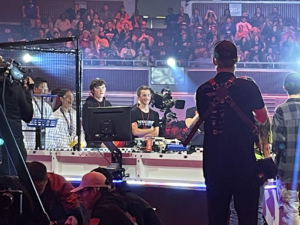 Middle School Champions during the competition
Middle School Champions during the competition
Another large component of the competition focused on the creation and organization of the team’s engineering notebook. Throughout the season, teams recorded their progress and all the work they’ve done on their robots, from their first prototype to their final design after many adjustments and long hours of trial and error. The purpose of the notebook is to show the judges the team’s thinking, processes and their progress. Without a good engineering notebook, teams cannot win many of the awards.
This year, VEX held two State competitions, split into middle school and high school, for our region, one in San Diego and another in Los Angeles. Teams from the Science Academy won both competitions (3324U & 3324B), qualifying them for Worlds. Other teams also qualified for Worlds either by having a high score in Skills or by the following awards: Excellence Award, Design Award, Robot Skills Champions, Innovate Award, Amaze Award, Think Award, or Build Award.
 Team 3324B at a state competition
Team 3324B at a state competition
The VEX Robotics World Championship was held in Dallas, Texas at the Kay Bailey Hutchison Convention Center Dallas from April 25 to May 5. The event was split into competitions for middle school and high school. Two of our high school teams competed from April 25 to April 27 and of our eight middle school teams participated from April 27 to April 29. Due to the large number of teams present at the World’s competition, VEX split the teams into different divisions. Within each division, each team participated in a mini competition, where the winners from each division advanced to the final elimination rounds in the so-called “Dome.” These rounds took place with thousands of people watching.
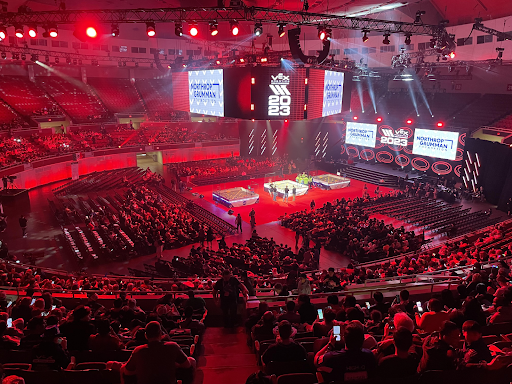 2023 Vex Robotics Competition
2023 Vex Robotics Competition
After a fierce competition between Science Academy’s Team 3324U (aka Supernova Team Hydra) and their alliance Shanghai’s Team 9123X against West Vancouver’s Team 10012W and their alliance Shanghai’s Team 9123C, Supernova Team Hydra and their alliance emerged triumphantly as the VEX VRC Middle School World Champions 2023! Despite being a first-year team, two eighth graders, Nicholas Mandreyka and Eero Wolfe, successfully created a robot worthy of a world championship. Congratulations to them!
The following Science Academy teams also won awards in their divisions as listed:
3324U Nicholas Mandreyka and Eero Wolfe Think Award
3324B Shivaan Nigam, Liam Cahill and Lily Kelsay Amaze Award
3324Y Aidan Limketkai, Gabe Cooper and Aaron Park Build Award
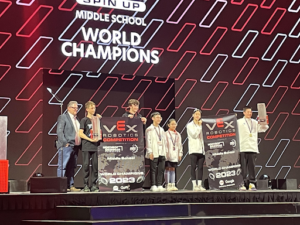
During the World’s competition, VEX also revealed the challenge for the 2023-24 season: Over Under. The goal of Over Under is to score as many points as possible by performing actions such as placing the game element (tri-balls) under goals or elevating the robot on a post at the end of the game.
Congratulations to all teams that participated in the 2022-23 VEX robotics season! Each and every team did a great job and has made the Science Academy very proud. A special congratulations to the members of 3324U, 3324B, and 3324Y for their accomplishments at the World Championship. Good luck to all teams competing in the 2023-24 season!
After the excitement of the World Championship, teammates Eero Wolfe and Nicholas Mandryka, the middle school winners of the 2023 VEX Robotics Competition, sat down with Milan Riley for an interview looking back over this momentous competition season:
1. What were your goals for this competition?
“Our goal for this competition was to win our division [500 teams are split into 6 divisions].”
2. What have you learned from past competitions and how are you putting that info to use now?
“What we have learned from past competitions was that ranking high before eliminations and alliance selection is important, as well as warming up before each match.”
3. What specific skills have you and your team been working on to prepare?
“Specific skills that our team has worked on to prepare was my driving because at high levels, robots are equally matched as they can score points at almost 100% efficiency and it comes down to the driving to determine who wins.”
4. What modifications have you had to make to your robot(s)?
“Some modifications that we have made to our robot was to have it shoot very fast so that when being defended, we can shoot all of our disks before being blocked. We also made sure that our expansion – we try to cover as many tiles as possible using string that is launched from the robot – does not fire out of the field so that we are not disqualified from the tournament.”
5. What were some highlights from the competition?
“Some highlights for the competition were of course winning it, but also after and during the competition when all of the teams were together having fun and supporting each other.”
6. Why do you think you guys did so well this year?
“Some reasons that we did so well this season was that we had great mentors and sister teams that helped us so much and motivated us to try so hard.”
7. What are you looking forward to working on in the future?
“We are looking forward next year to competing in high school with new members on the team and being able to help the new teams that were once us.”
8. What capabilities are you looking forward to the robotics world developing in the future in the competition world? What about in terms of real-world applications?
“As new technology like more efficient electronics become accessible, teams will be able to do even more and create amazing robots that can compete at levels unimaginable right now. VEX robotics takes a lot of real world robotics concepts and incorporates them into the competition, meaning that as technology becomes better, so will the robotics in the real world.”

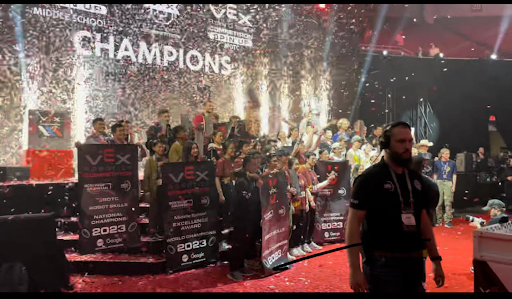
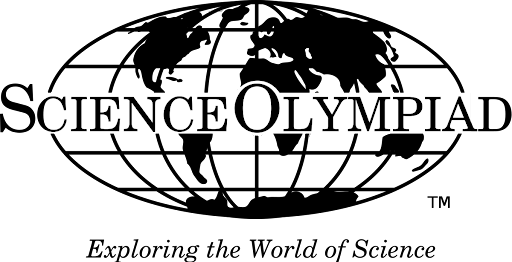
Science Olympiad
by Tarisha Hasan
What is the Science Olympiad?
Science Olympiad is the premier team STEM competition in the nation, providing standards-based challenges to 6,000 teams at 425 tournaments in all 50 states. Science Olympiad competitions are like academic track meets, consisting of a series of 23 team events in each division (Division B is middle school; Division C is high school). Each year, a portion of the events are rotated to focus on genetics, earth science, chemistry, anatomy, physics, geology, mechanical engineering and technology. By combining events from all disciplines, Science Olympiad encourages a wide cross-section of students to get involved.
The competition is divided into several events, which vary every year. It is designed to test science knowledge in various ways, including (but not limited to) scientific design, tests, and build events. Certain events are more time-consuming and intensive than others: for example, Rollercoaster, where you build a stylized ramp for a ball to roll down for a target time, and Flight, in which teams build a rubber-band powered airplane vs. an event like Fast Facts, which is more a test-based “core knowledge” event. The more events your team participates in and the more events you finish in the top three places, the higher your team’s ranking.
Regional competitions typically involve schools from a specific region, usually within the same state. Our State competition takes students from schools all over California, and Nationals will likely involve teams from every single state in the United States. The experience is highly rewarding, and it can be a valuable addition on applications one may have for colleges, internships, and future jobs. With that in mind, I want to provide a thorough review of this year’s competition so that students can get a better idea of what the competition entails. Before we get started, I would like to thank and congratulate all participants in this year’s Science Olympiad competition from both Division B (middle school) and Division C (high school).
What happened on this year’s trip?
The competition this year took place at Antelope Valley College, which is about an hour northeast from the Science Academy/EVHS campus. Both Divisions B and C camped outside of Yoshida Hall to gather, prep, and give each other support. Most events (except for Green Generation B/C, Dynamic Planet B/C, Roller Coaster B, It’s About Time C, Flight B/C, Storm the Castle B, Trajectory C, Wifi Lab C, and Sounds of Music B) took place in either Uhazy Hall (UH) or Sage Hall (SH). It was quite a large campus, so all participants were provided with maps in order to navigate the competition properly. Very few events this year seemed to be available to both the middle and high school divisions, with most events being exclusive to one division or another.
Although Antelope Valley College might not be that well known to students, it was nevertheless a huge campus, making it very easy to get lost, so we found that it’s always important to leave yourself plenty of time to get to your events. The college buildings contained many fascinating things, such as an anthropology exhibit, professional lecture halls, and well-equipped chemistry labs, so between events, we definitely did some sightseeing.

Image #1: Map of the Antelope Valley Campus
Personal experience
Because of the events I selected, my first event wasn’t until the afternoon at 1:20 pm. Luckily, the vending machines worked fine, and the snacks that we brought on the trip were also decent, which gave me an excuse to try matcha-flavored Choco Pies for the first time.
One of my first events was the Write It, Do It event, which is both fun and a bit nerve-wracking. Teammates are placed in separate rooms; one teammate writes down instructions for building an unnamed and unpictured item, and the other has to correctly build it. Although I will admit I’m not the best architect in the world, I still think I did a pretty decent job building the compound object from my teammate’s instructions. The materials were pretty fun to fidget with and link together, and the wooden blocks made almost perfect Jenga pieces. Even then, when the time came to build the actual object, it reminded me of trying to follow a recipe shoved into Google Translate multiple times before being translated back into English.
Fast Facts, a core knowledge test event, which was overall a pretty successful event for us, had some name categories that were challenging, including parts of the brain and anatomy. Unfortunately, I completely bombed the Biotechnology category, so those are areas I’ll want to study more in the future.
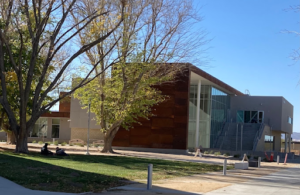
Image #2: Sage Hall, where I did the Write It, Do It event.
Why should you participate in Science Olympiad?
Despite the rigor that the competition has, it is well worth the effort. Not only is it fun, but participation in the event, even if you don’t place at the top or even the top three, will look excellent on a college application. These days, colleges look for students who are well rounded and capable of a high level of endurance in times of difficulty. Participants in the competition have the potential to win huge prizes: not just trophies, medals and plaques, but also scholarships, which can make going to college a lot more economically feasible. This, in turn, can allow you to pursue the career you want, especially if it’s a STEM career. If you’re interested, you should talk to Mr. Nuno and join his Per. 7 Science Olympiad elective next year.
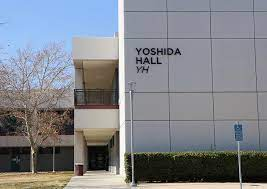
Image #3: Yoshida Hall. Most of us camped out near the entrance of this place, more precisely, near the tree shown at the left of the hall
Science Olympiad Trivia
- The first recorded Science Olympiad competition was held on Saturday, November 23, 1974 in Laurinburg, North Carolina at St. Andrew’s Presbyterian College.
- The list of events changes every year, but the core categories remain the same: Core Knowledge, Build, and Hands-On. Hybrid events can be a combination of any of these categories.
- And finally, a word of advice:
- If this is your first Science Olympiad competition, I would highly recommend selecting an event that is Core Knowledge only; these events only require research in order to completely understand the requirements.
- If you are good at building, you may want to take on Build events. They are rewarding to design and often come in the form of models of practical everyday objects. However, these events can be time-consuming, so take them as early as possible.
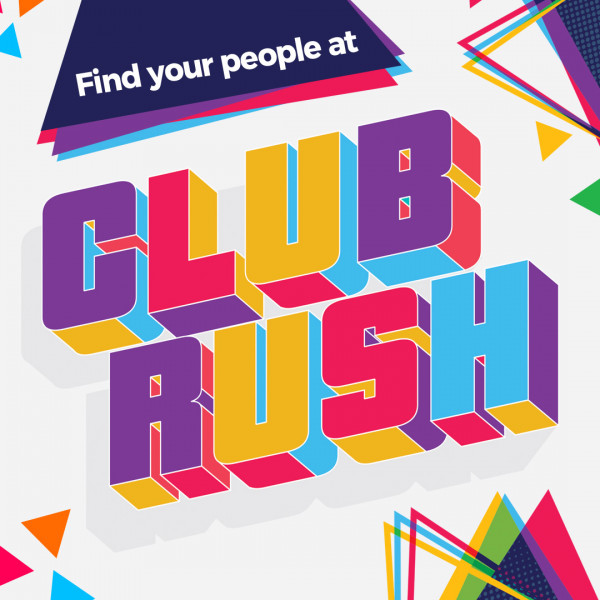
Club Rush
by Muaz Reza
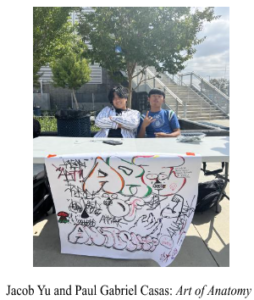 Science Academy’s first annual Club Rush occurred from Wednesday, September 14th – Friday, September 16th. Students could browse and sign-up from over 40 different clubs featured in the three days the event took place. Joining a club is a good way for middle and high schoolers to expand upon their extracurricular pursuits or even simply explore a craft or topic that piques their interest. With an assortment of diverse clubs, from those building upon students’ creative pursuits to STEM clubs supplementing and expanding upon material learned from Science Academy’s curriculum, students have a wide selection they can choose from to join.
Science Academy’s first annual Club Rush occurred from Wednesday, September 14th – Friday, September 16th. Students could browse and sign-up from over 40 different clubs featured in the three days the event took place. Joining a club is a good way for middle and high schoolers to expand upon their extracurricular pursuits or even simply explore a craft or topic that piques their interest. With an assortment of diverse clubs, from those building upon students’ creative pursuits to STEM clubs supplementing and expanding upon material learned from Science Academy’s curriculum, students have a wide selection they can choose from to join.
If you have an idea for a club or want to join a club featuring a topic that does not exist yet, consider starting a club. Introducing your passion to the Science Academy community enables other students to explore new interests or simply to find a group of like-minded individuals who share in your craft. It is also a great addition to anyone’s resume and allows one to meet new people and build new connections.
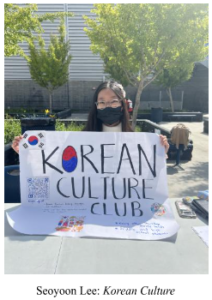 ASB will be hosting Club Festival next semester to reintroduce clubs to the Science Academy community and to showcase new clubs for the semester. It will showcase the milestones and achievements of clubs from the past semester and reestablishes interest in clubs. ASB will take the critique and feedback from Club Rush and apply them to Club Festival to create a festive and accessible atmosphere to celebrate our clubs.
ASB will be hosting Club Festival next semester to reintroduce clubs to the Science Academy community and to showcase new clubs for the semester. It will showcase the milestones and achievements of clubs from the past semester and reestablishes interest in clubs. ASB will take the critique and feedback from Club Rush and apply them to Club Festival to create a festive and accessible atmosphere to celebrate our clubs.

Aviation Club
by Ryan Park
The Aviation Club is a new club formed this year that helps to educate members around aspects of the field of aviation and to teach its members the mechanics and engineering behind aviation. It was founded by Aviation Club president, Solomon Sharp, who answered a few questions recently in order to encourage students to join. The club meets every Wednesday after school in Mr. Bradfield’s room, located in W30.
When simulating a version of flight, the Aviation Club uses multiple tools in order to have members experience the closest thing to real flight. They have multiple tools that have been programmed to act like the real tools you would find in an aircraft such as the yoke, also known as the control stick. The yoke is used in order to control the movement of the aircraft inside the simulators.
What is the purpose of your club?
The Aviation Club is based on educating our members about all aspects of aviation as a whole and teaching them how to use flight simulation technology. As the world is in high demand for pilots and engineers, having knowledge and experience in the field is an important foundation when choosing a career related to aviation. Being involved with aircraft requires many different skills, many of which are applicable to everyday life, and none are exclusive to a specific field. When I started my training as a pilot several years ago, I realized how much I wanted to share this world with other people wanting to take that first step, and how beneficial it could be to their lives.
What is some background info about your club?
A technical and mechanical understanding of aircraft, such as understanding the science of how a vehicle flies and what comes with it, is important not only for engineers but for pilots as well. Flying requires a fundamental understanding of the machine you are commanding and by having that understanding, you can be that much more effective. Aerodynamics, engine mechanics, electronics, and more all go beyond aviation and can be applied in many different fields. One of the most important skills in the world of aviation, though, is of teamwork. Every pilot, engineer, and mechanic all work in conjunction with one another, and none can work with a missing link.
What are some major projects you plan on releasing?
This year, one of our goals is to get everyone hands-on experience with real aircraft, both for maintaining them and flying them. We have already formed strong connections with professional aviators, and the date is currently being coordinated for these goals to be achieved. We are also shooting for designing a remote control model for a plane/drone and constructing it to demonstrate the effectiveness of our design.
What would you say to people interested in your club?
To anyone who is interested in the club, feel free to come and check it out! If you want to see what we’re up to, come to Mr. Bradfield’s room on Wednesdays after school and you might catch us on the simulators. We would love to have new members, and if anyone is interested in joining, come and let me know!


 Club pictures
Club pictures

Science Bowl Success
by Daniel Svediani
This February, our very own Middle School Science Bowl Team successfully qualified for the National Science Bowl competition in Washington, D.C. by winning the Southern California regional Science Bowl competition! We are overjoyed by our students’ performance and would like to congratulate each and every team member. Our star five-person team consists of Naira Badalyan (7th grade), Saket Pamidipathri (8th grade), Ryan Lee (8th grade), Sean Yeh (8th grade), and Eric Chung (6th grade), and we would like to individually congratulate each and every one of them for their incredible performance as well as their amazing co-coaches, Ms. Musial and Jaden Penhaskashi. This has been a dream come true and the Science Bowl Club has been building up to this moment since we moved to our new North Hollywood location. In 2019, our middle school team placed in the top five; in 2020, our middle school team placed third; in 2021, our middle school team placed second; and this year we finally placed first!
So, in honor of all of our past and current Science Bowl team members, we wanted to enlighten everyone with the history of the Science Academy Science Bowl team by interviewing the team’s founder, Jaden Penhasakshi:
“In 2016, I was lucky enough to be able to create our middle school’s first Science Bowl team thanks to the help of previous coach and current Science Academy teacher, Mr. Knauss. At the time, Science Bowl was uncharted territory, but we were ready to accept any challenges in an effort to increase our knowledge and understanding of scientific studies. We formed a team of five people, four of whom attend Science Academy to this day, and we began our journey.
“We spent our first few years learning from our mistakes and gaining experience, but we only truly began to flourish during our third year of competition, where we placed second place in the Southern California regionals with the help of one of our school’s science teachers, Ms. DiMonaco. The next year we placed third and the following year, second again. It was a grueling process, but coming so close to advancing and qualifying for Nationals constantly pushed us to work harder and harder year after year.
“During the same time, our oldest middle school competitors advanced to the high school tournament, a difficult transition, because the majority of teams at the competition were composed of seniors, while our school only had freshmen. Similar to our middle school experience, we never gave up working harder and harder each year, seeing the fruits of our labor ripen as we slowly climbed in ranking.
“And that leads us to where we are today. Our current coach Ms. Musial has hosted our club for the past year and her help as well as all of our previous coaches has undoubtedly brought us the victory that we are proud to have today. We currently have four teams, two middle school teams and two high school teams, and hope they achieve similar success within the coming years. So let’s cross our fingers for all of our Science Bowl teams and wish them luck!”
Feel free to talk to Ms. Musial or any of the Science Academy Science Bowl members if you are interested in joining the team and check out our website to find out more about Science Bowl: https://stemsciencebowl.weebly.com/

Our first Science Bowl team.

Our current Science Bowl team.
From left to right: Jaden (student coach), Naira Badalyan,
Saket Pamidipathri, Ryan Lee, Sean Yeh, Eric Chung
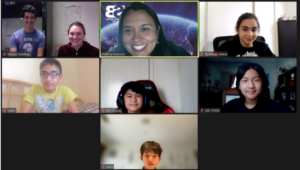

Día de Los Muertos/Day of The Dead
The LatinX Student Union
Día de Los Muertos
Día de Los Muertos/Day of the Dead is celebrated yearly on November 1st and 2nd. The purpose of the holiday is to remember loved ones who have passed away. On Día de Los Muertos, families visit graves, make food that their departed loved ones once enjoyed, and create altars called ofrendas. Traditional components of the ofrenda are photographs, food offerings, mementos, candles, and orange flowers called cempasuchil (marigold) to decorate the altar and the gravesite.

To celebrate this holiday, the LatinX Student Union put up a traditional ofrenda in the main hallway on the 3rd floor. The ofrenda featured important Hispanic figures, such as Frida Kahlo, Selena Quintanilla, Evangelina Villegas, and Antonio Aguilar. Frida Kahlo was a surrealist Mexican painter who is known for her self-portraits. Selena Quintanilla was a Mexican-American musical artist and is known as the “Queen of Tejano Music.” Evangelina Villegas was a biochemist and was critical to the development of high-quality protein maize. Lastly, Antonio Aguilar is a widely recognized Mexican singer.

The LatinX Student Union also held a fundraiser by selling traditional Mexican candy and pastries. Thank you to everyone who stopped by!
Read More

Club Spotlight: STEM Clubs
STEM Clubs at the Science Academy STEM Magnet
by Milan R. and Muaz R.
At Science Academy, we have a wide range of clubs, all focusing on a variety of subjects, skills, and potential occupations. In this article, we take a look at three of our STEM-focused clubs: StellarXplorers, the Applied STEAM Club, and Math Counts. Stellar Xplorers and Math Counts are sponsored by our wonderful assistant principal, Mr. Rosenthal, while the Applied STEAM Club is sponsored by Mr. Bradfield and led by fellow students Zygmunt R, Nikita A, and Oliver P. All of these clubs feature the use of many different skills in science, technology, engineering, math, and more.
Stellar Xplorers
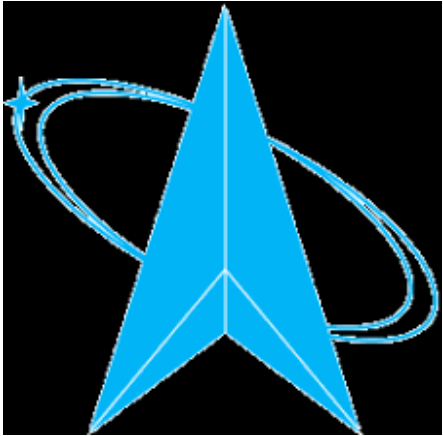 Stellar Xplorers is a high school space-based competition, founded by the National Air Force Association (AFA), that encourages students to use their skills in mathematics, science, and engineering in order to solve real-life problems. Students must grapple through many different computer-generated scenarios, while keeping in mind all the variables that could affect their aircraft, such as launch speed and orbital velocity. Working and familiarizing themselves with these concepts allows pupils to gain a greater advantage when applying these skills to real-life jobs in major organizations and companies such as NASA, JPL, and SpaceX.
Stellar Xplorers is a high school space-based competition, founded by the National Air Force Association (AFA), that encourages students to use their skills in mathematics, science, and engineering in order to solve real-life problems. Students must grapple through many different computer-generated scenarios, while keeping in mind all the variables that could affect their aircraft, such as launch speed and orbital velocity. Working and familiarizing themselves with these concepts allows pupils to gain a greater advantage when applying these skills to real-life jobs in major organizations and companies such as NASA, JPL, and SpaceX.
In order to get a more personal overview of what it’s like participating in the club, we interviewed Zachary M. (8th) on his experiences.
“I first started Stellar Xplorers in the sixth grade. It’s been a great experience so far — Stellar Xplorers has taught me about the different elements of satellite design, weighing the cost-effectiveness of different crucial satellite subsystems, the six classical orbital parameters, and evaluating the data transfer from satellites to satellites and stations, and much more. I would recommend anyone who likes space and is willing to join a team to become a Stellar Xplorer. A lot of Stellar Xplorers is not only about participating in the competitions but also having a good time with your friends. It’s one of the most fun things I’ve done this year and it always gives me something to look forward to. Also, scholarships are given to the top three teams, so that gives an incentive as well. Although you probably couldn’t use the material you learn directly after you participate in a competition when you get older, these competitions can give you some of the necessary knowledge and experience required to be able to work at companies like JPL, NASA, or SpaceX. In my opinion, there is absolutely no prior experience necessary to join this club. I came in knowing nothing about any of the topics I listed prior, but after participating in the competitions and learning about satellites and rockets through this club, I would now consider myself knowledgeable on all of them.”
StellarXplorers explores a wide variety of different topics in STEM fields and allows students to exercise skills that they can apply to real-world careers. If you would like to develop these skills for a present and future occupation, or simply have an interest in what lies beyond the great skies, consider joining Stellar Xplorers! You can do so by emailing Mr. Rosenthal about your interest in the club.
Math Counts
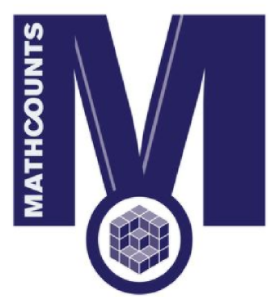 Are you deeply interesting and curious about the mysteries of mathematics and the beauty it encompasses? Or are you simply looking for a way to stretch your brain and increase your critical thinking skills? Math Counts features a solution to both of these problems! Hosted by Mr. Rosenthal, the club grants a way for students to converse and solve math problems with one another as well as increase their logical and critical thinking skills at the same time. Math Counts tackles problems in many different fields of mathematics, including algebra, geometry, probability, and statistics.
Are you deeply interesting and curious about the mysteries of mathematics and the beauty it encompasses? Or are you simply looking for a way to stretch your brain and increase your critical thinking skills? Math Counts features a solution to both of these problems! Hosted by Mr. Rosenthal, the club grants a way for students to converse and solve math problems with one another as well as increase their logical and critical thinking skills at the same time. Math Counts tackles problems in many different fields of mathematics, including algebra, geometry, probability, and statistics.
In order to get a more personal overview of what it’s truly like in the club, we interviewed two club members:
Saket P. (8th): “I first started Math Counts in 6th grade when it was a small group of 6, and we just did math problems and math competitions. We entered competitions like the AMC 8, 10, 12, the Math Olympiad, and the Math Counts and Purple Comet. I would recommend anyone who likes competitive math to come to join, or if you like fun math problems. Most of the stuff you learn can help you gain an advantage in the competition and can help us beat rival schools. I don’t believe there is a need for prior knowledge, you just need to be interested in math. But if you want a list of subjects to prepare for the competition, there are algebra, geometry, number theory, and probability. Math Counts is an amazing club for anyone interested in math. I am excited to see how this club ends up in the years to come.”
Ryan L. (7th): “I first started Math Club just when it was announced by Mr. Rosenthal. The club is a great way to practice skills that you have already learned as well as develop new ones. It’s a great opportunity to have fun with math, and I was able to incorporate the math questions I have answered there with various problems on the AMC and Math Counts. I believe that some prior knowledge is needed, at least algebra. The club is there to learn and practice math. The people who already know the math are able to practice the problems, and more importantly explain how to do the problem to the other students, allowing the other students to learn and allowing all the students to gain more experience in articulating the process and solution.”
Math Counts provides an environment for students to engage in different mathematical challenges and problems with one another in order to expand upon their logical and critical thinking skills. If these activities sound enjoyable to you, consider emailing Mr. Rosenthal about your interest in the club!
Applied STEAM
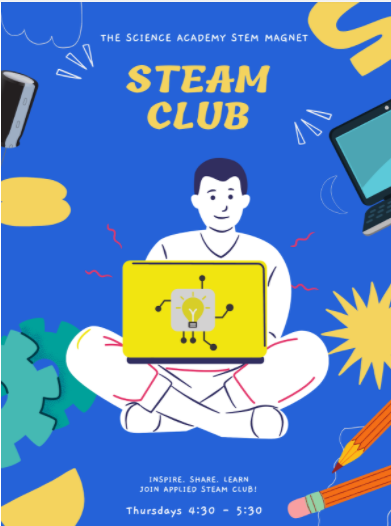 Are you interested in MakerSpace, electronics and/or engineering? If so, you should know the Applied STEAM Club has been devoted to a combination of these topics since they formed in January 2021.
Are you interested in MakerSpace, electronics and/or engineering? If so, you should know the Applied STEAM Club has been devoted to a combination of these topics since they formed in January 2021.
The Applied STEAM Club aspires to be a “community of STEM enthusiasts to showcase cool projects and ideas.” Together, members of the club collaborate on projects and work on them to perfection. Other than collaborating, students “communicate with each other in the STEAM club whether it be through Zoom or Discord”. Their Zoom meetings are every Thursday from 4:30 PM to 5:30 PM.
One of their major goals is to “acquire more members in order to make bigger projects and have better collaborations”. The club representatives are also hopeful the club can meet in person when school returns to normal, and therefore make collaborating easier.
The Applied STEAM Club is sponsored by Mr. Bradfield with Zyg R, Oliver P, and Nikita A as their representatives. To enter the club, students can use the access code from the S.A. Student Body Outreach to join their Schoology group, and they can attend their meetings.
Read More
Club Spotlight: Red Cross Club and Pre-Med/Future Doctors of America Club
by Hayley Yoon
The Science Academy offers a wide range of clubs. Clubs can be described as one of the highlights of school, especially during this time of distance learning, which is why students are encouraged to participate in them. They can be centered around a variety of subjects, including those that match up with students’ passions. By joining a club that you are passionate about, you can learn more about the topic, meet people who share your interests, and gain various experiences, including serving the community. For students interested in the medical field, the Science Academy has two clubs to offer: the Red Cross Club and the Pre-Med/Future Doctors of America Club.
Red Cross Club
The Red Cross Club is designed to provide students with various information on understanding and preparing for natural disasters, along with opportunities to take action as a volunteer. Students who participate in these activities learn more about the world of emergency assistance and develop strong leadership skills that can be applied in all situations.
Most students will be familiar with American Red Cross as a large, public organization, but many may not know about the programs available to them. This club was established to inform other Science Academy students about these opportunities, and allow them to gain valuable volunteering experiences from them. Students who would like to study in the medical field would benefit greatly from this club by gaining a variety of experiences while following their interests.
Members of the Red Cross Club take part in a list of activities, from learning about Red Cross’ efforts to alleviate human suffering all the way to First Aid and CPR training. Information about all types of services including services toward Armed Forces, training services, blood donor services, disaster services, and international services. They also attend meetings held by the Glendale Youth Corps, allowing the students to speak comfortably with peers while earning volunteer hours. The club also hosts events like fundraisers and donation drives to aid in humanitarian issues. Last year, the club hosted a Veteran’s Wishlist Drive, earning many donations that were gifted to Los Angeles area veterans.
High school students may be looking for volunteer opportunities among the clubs, which the Red Cross Club provides. All activities affiliated with Red Cross allow students to gain volunteer hours, and club members are also invited to participate in events held by other youth corps, especially in the Glendale area. Although the pandemic prevents students from volunteering in person, this club allows students to take advantage of online volunteer events such as educational courses, fundraisers, and drives.
Pre-Med/Future Doctors of
America Club
The Pre-Med/Future Doctors of America Club is another Science Academy club students may be interested in. Joining this club would allow students to be educated on current events and opportunities regarding the medical field.
This club was created for students who had a passion or interest in the medical field, or students who simply were curious and wanted to learn more about it. The founder of the Pre-Med club believed it was important for students to be able to pursue their interests at school, and opened up this club as a path for students like herself.
In the Pre-Med Club, students learn about current issues and topics in the world of medicine, such as the effects and implications of COVID-19 on healthcare. This club has a variety of activities and plans, including plans to invite guest speakers including medical students or doctors, debates regarding medical controversies, and remote volunteering opportunity information. When asked how remote learning had affected the club, the club representative replied that the effect was actually positive. Before, large numbers of students had to gather in a single classroom to watch the powerpoint presentations, which was a difficult task and process. However, thanks to online Zoom meetings, presenting slides and setting up meetings has become easier.
Volunteering opportunities have become difficult to find due to the virus. The Pre-Med Club is looking into remote volunteering opportunities related to the medical field so that students can earn service hours as well as experience what kind of work is related to the area of study.
To join either or both the Red Cross Club and the Pre-Med/Future Doctors of America Club, visit the Science Academy Clubs website (available in the S.A Student Body Outreach Schoology group) and join the Schoology group of the club according to the code provided. The meeting dates and time for both clubs can be found on this website as well.
Read More

